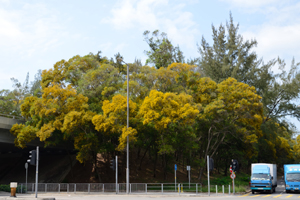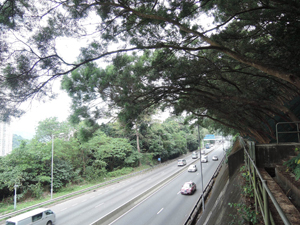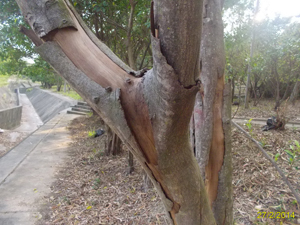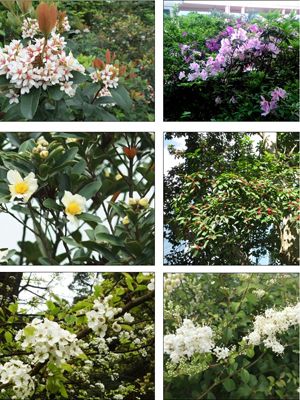Curtain falls on Acacia
|
Despite its foreign origin, Acacia confusa (Acacia) is often found on man-made slopes along the roadsides. This is due to the fact that a lot of man-made roadside slopes were constructed in the past half-century thanks to the rapid development of infrastructure and road networks in Hong Kong. To prevent soil erosion, stabilise slopes and increase vegetation, Acacia was introduced on a massive scale and planted on these man-made slopes because of its fast growing nature on arid land, and has since become the “pioneer” of urban greening in Hong Kong. Every year after springtime, we can often see seas of golden flowers blooming across the territory that touch up our roadside environment. However, like other living organisms, trees undergo the life cycle of birth, ageing, sickness and death. According to tree experts, the average life span of Acacia is about 50 to 60 years. The Acacia extensively planted in the 1950s to 60s in senescence. Many have developed health and structural problems, and may have myriad illnesses in the near future. According to the findings of the Tree Management Office (TMO), 35 percent of tree collapse incidents in recent years involved Acacia extensively planted from the early days. Tree management records of the Highways Department (HyD) also show an upward trend of Acacia removal in recent years because of their high risk. You may still remember that several tree collapse incidents involving Acacia in recent years have resulted in personal injury, orserious traffic obstruction. We, need to face the potential safety threats posed by these ageing Acacia. Since Acacia is an exotic species of relatively low ecological value, mass planting along the roadsides and on man-made slopes may hinder natural reproduction and growth of native trees, resulting in a lack of diversity and vitality in roadside ecology. In this regard, the HyD is implementing the "Enhancement of Vegetated Slopes of HyD - Phased Replacement of Senescent Acacia" programme for proactive and better tree management. The programme aims to systematically replace the Acacia planted on vegetated slopes under its management, so as to reduce the number of tree collapse incidents, improve the safety of road users, and enhance the roadside landscape and its ecological value. Under the programme, the HyD will consult local and overseas tree experts, the TMO, relevant scholars and district councils on preliminary proposals. A systematic plantation survey will then be conducted on various aspects such as the distribution, scope and habitat conditions of plantation areas. After analysis of the findings, the order of priority for replacement will be set, and the ageing Acacia will be thinned out gradually as planned and be replaced with appropriate species. The HyD will draw up detailed plans regarding the scale and schedule of tree thinning taking into account its traffic and visual impacts on each site and related environmental factors and physical constraints. In determining the species, quantity and planting schedule of replacement trees, the department will also follow the fundamental principle of “Right Tree, Right Place” promulgated by the Development Bureau. More native plants (such as Gordonia, Hong Kong Hawthorn and Reevesia) and localised plants (such as Camellia, Purple Azalea and Golden Dewdrop) will be grown to re-shape the natural habitats. This will not only enhance roadside landscape and enrich community characteristics, but also contribute to biodiversity and ecological value. This massive tree replacement and enhancement programme is very important with far-reaching effects. In implementing the programme, the HyD will carefully consider all the factors related to the works and the required traffic arrangements. It will also conduct in-depth study with local and overseas experts, the TMO and relevant scholars, and will brief the relevant district councils on the programme and consult the public. The Government will continue to adhere to the goal of “People, Trees, Harmony” when promoting urban greening. We hope that budding and healthy trees will soon appear along the roadsides in various districts across the territory. |
|
15 May, 2016
Back


